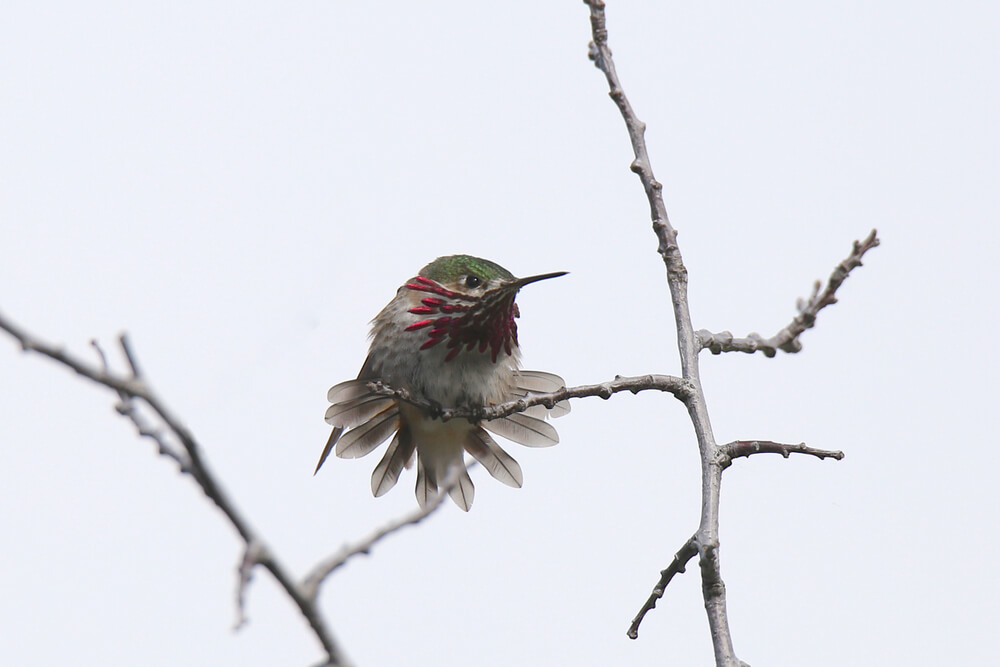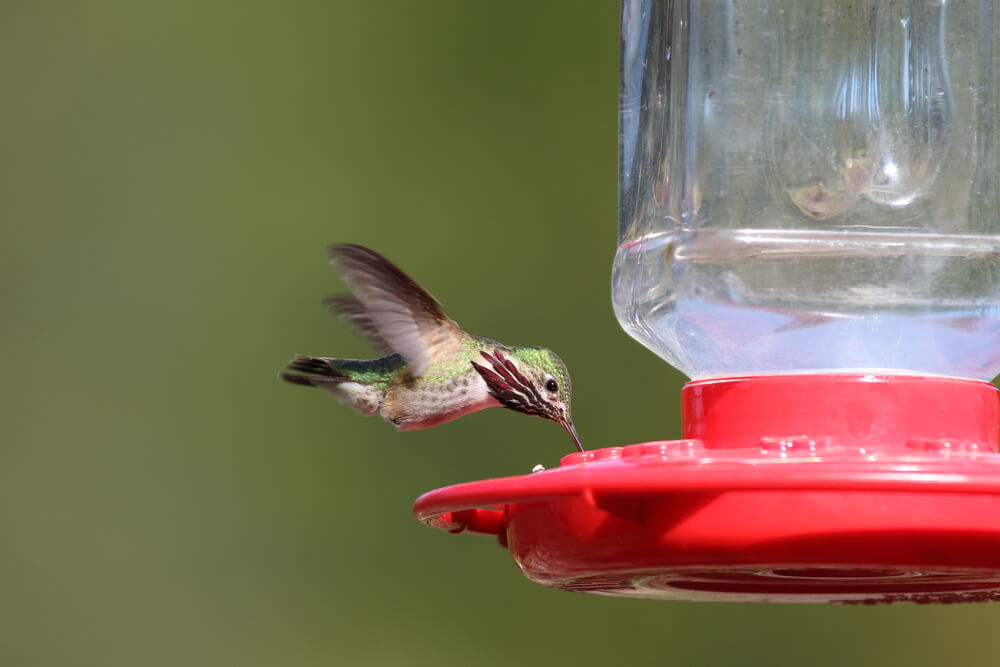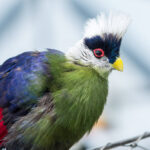The Calliope hummingbird is the smallest bird in North America, at approximately 3 inches long and 1/10 of an ounce.
Even though tiny, it can thrive on colder summer nights in its range and migrates an impressive distance of more than 5,000 miles.
The male Calliope hummingbird dazzles with his magenta-colored throat and sharp, buzzing tail, and high-pitched call.
This article provides detailed information below about the Calliope hummingbird and ways you can attract it to your yard.
Calliope Hummingbird
Overview
Scientific name: Selasphorus calliope
Length: 3.1 – 3.5 inches
Wingspan: 4.1 – 4.3 inches
Weight: 0.08 to 0.12 ounces
As the smallest bird, the Calliope hummingbird is easier to identify. It also has a shorter bill, with a short, broad, un-forked tail.
Males and females both have green backs and heads with darker feathers along the wings and tail. The males have magenta gorgets (throats) with unusual feather patterning.
Like other hummingbirds, the males court to impress females for breeding with beautiful flights and feather displays. The females are responsible for nest building and raising offspring.
They are very territorial, chasing off many other species of birds.
Male

Males have magenta feathers that stretch out like sun rays from the underside of the bill, down the throat, and onto its upper sides.
These streaked rays of feathers are unlike the feather patterning of other hummingbirds with a solid patch.
They have a bronze-green back with darker hues along the wings and tail.
Juvenile males may have some magenta feathers in spots on the throat.
Female

Females and juveniles have a peachy tone to their underbellies and bronze-green backs. The throat is mostly white with some green stippling. The corners of their tail feathers have some white coloration.
Female (and immature) Calliope hummingbirds often are confused with female Rufous and Allen’s hummingbirds. The best way to tell them apart is to look for the Calliope’s smaller, shorter bills and peach coloring.
Behavior

Males will aggressively defend their territories and breeding grounds.
They spend over half of their time perched in hunched positions on exposed branches to watch over territories. Most commonly they are seen perched on alder and willow trees.
This positioning allows them to quickly chase off intruders such as sapsuckers, red-tailed hawks, robins, and more. However, they are more submissive to other larger hummingbird species on wintering grounds (Mexico).
This video shows a male Calliope hummingbird perched on a branch:
Range

In the winter, Calliope hummingbirds migrate to the southwestern coast of Mexico.
During the spring and summer breeding season, they are found in parts of California, Oregon, Washington, Utah, Wyoming, Montana, and Utah. They are also found in southeastern British Columbia and southwestern Alberta, Canada.
Their range is showing signs of expansion into southeastern parts of the United States.
Diet

Calliope hummingbirds drink nectar and eat insects.
They most commonly feed from flowers close to the ground, hovering to extract the nectar. Calliope hummingbirds typically drink from smaller tubular or cup-shaped flowers that are not visited by larger hummingbirds.
They also visit hummingbird feeders with sugar water, by either hovering or perching.
These hummers pluck small insects from foliage and bloom, or they catch them on the wing mid-air.
Calliope hummingbirds will regularly feed from sap wells created by their sapsucker relatives, taking in both sap and insects.
Habitat

The tiny Calliope hummingbird is found breeding in cooler montane meadows, alder and willow thickets near water, canyons, and in regenerating forests (after fire or logging).
Their habitats are generally at elevations of 4,000 to 11,000 feet, but some are hummers spotted lower.
During their migratory paths, they are found visiting desert washes, coastal scrubs, streamsides, lower coastal forests, subalpine meadows, thorn and pine-oak forests, and brushy edges.
Breeding

Male Calliope hummingbirds perform a U-shaped courtship display with steep dives and a high-pitched call.
At the bottom of the dive, they move their feathers in such a way that they make a popping, buzzing, or zinging sound.
They also hover in front of the female and flare out their magenta throat feathers.
Males court more than one female, leaving females to care for the young on their own.
Nesting

After breeding, the female builds a nest in a pine tree, conifer tree, evergreen tree, or deciduous shrub anywhere from 6 to 40 feet high. She chooses a spot that offers some protection with foliage.
Females often build nests where an old pinecone grew, and the nest can look much like a pinecone.
The nest is compact cup-shaped, made of plant down and fibers, spider webs, moss, and lichen. It is about 1 ½-inches wide and less than 1 inch deep.
The female Calliope hummingbird bird then lays 2 white eggs and incubates them for 15 to 16 days. The hatchlings then leave the nest 18 to 21 days later.
She may breed again and have a second brood, reusing the previous nest or building a new one on top of the old one.
Migration

The Calliope hummingbird is the smallest long-distance migrant, traveling over 5,000 miles.
In the early spring, it moves northwest through the Pacific lowlands and then through the southeastern Rocky Mountains in the Fall. Summers are spent in B.C. and the northeastern U.S.
Wintering grounds are in central Mexico, Mexico City, and western coastal areas such as Colima and Puerto Vallarta. Calliope hummers have also been spotted in Texas and Louisiana during this time.
Conservation

Calliope hummingbirds are of low conservation concern. However, their restricted wintering grounds, primarily in Mexico, put them “on watch” to make sure they continue to thrive.
If land development or natural disasters affect their range, it may negatively impact their population growth.
How To Attract The Calliope Hummingbird

Calliope hummingbirds can be found feeding on flowers low to the ground. However, males are most often seen perched high above their territories.
If you live within their range, offer them native tubular or cup-shaped plants such as larkspur and columbine.
Add a hummingbird feeder with the perfect sugar-water recipe and a shallow bird bath to your yard as well.
Calliope Hummingbird Facts
- The Calliope hummingbird weighs about as much as a ping pong ball, making it the smallest bird in the U.S.
- This hummer is named after the Greek mythological muse Calliope of Homer’s Iliad and Odyssey.
- Calliope hummingbird birds go into torpor during cool summer nights to conserve energy and survive the temperatures.









![Bald Eagle Population By State: 2023 Statistics [Data] Bald Eagle Population By State: 2023 Statistics [Data]](https://birdchronicle.com/wp-content/uploads/2023/01/three-bald-eagles-perched-150x150.jpg)

